Characterization of Electromagnetic Pulses Generated from Plasma Associated with Laser Filaments-Excited Aluminum Alloy Interaction
Abstract
:1. Introduction
2. Experiment
3. Experimental Results and Discussion
3.1. Distribution of the EMPs in the Time and Frequency Domains
3.2. Spatial Distribution of EMPs
3.2.1. Distribution of EMPs with Different Detection Distances
3.2.2. Distribution of EMPs on Different Angles
3.3. Effect of Different Laser Pulse Widths on EMPs
3.4. Dependence of the Power of EMPs on the Laser Pulse Energy
4. Conclusions
Author Contributions
Funding
Institutional Review Board Statement
Informed Consent Statement
Data Availability Statement
Acknowledgments
Conflicts of Interest
References
- Consoli, F.; Tikhonchuk, V.T.; Bardon, M.; Bradford, P.; Carroll, D.C.; Cikhardt, J.; Cipriani, M.; Clarke, R.J.; Cowan, T.E.; Danson, C.N.; et al. Laser produced electromagnetic pulses: Generation, detection and mitigation. High Power Laser Sci. Eng. 2020, 8, e22. [Google Scholar] [CrossRef]
- Consoli, F.; De Angelis, R.; Andreoli, P.; Cristofari, G.; Di Giorgioa, G. Measurement of the Radiofrequency-microwave Pulse Produced in Experiments of Laser-plasma Interaction in the ABC Laser Facility. Phys. Procedia 2015, 62, 11–17. [Google Scholar] [CrossRef] [Green Version]
- Prencipe, I.; Fuchs, J.; Pascarelli, S.; Schumacher, D.W.; Stephens, R.B.; Alexander, N.B.; Briggs, R.; Büscher, M.; Cernaianu, M.O.; Choukourov, A.; et al. Targets for high repetition rate laser facilities: Needs, challenges and perspectives. High Power Laser Sci. Eng. 2017, 5, e17. [Google Scholar] [CrossRef] [Green Version]
- Brown, C.G.; Throop, A.; Eder, D.; Kimbrough, J. Electromagnetic pulses at short-pulse laser facilities. J. Phys. Conf. Ser. 2008, 112, 032025. [Google Scholar] [CrossRef] [Green Version]
- Raczka, P.; Cikhardt, J.; Pfeifer, M.; Krasa, J.; Krupka, M.; Burian, T.; Krus, M.; Pisarczyk, T.; Dostal, J.; Dudzak, R.; et al. Measurement of strong electromagnetic pulses generated from solid targets at sub-ns kJ-class PALS laser facility. Plasma Phys. Control. Fusion 2021, 63, 085015. [Google Scholar] [CrossRef]
- Xia, Y.; Zhang, F.; Cai, H.; Zhou, W.; Tian, C.; Zhang, B.; Liu, D.; Yi, T.; Xu, Y.; Wang, F.; et al. Analysis of electromagnetic pulses generation from laser coupling with polymer targets: Effect of metal content in target. Matter Radiat. Extrem. 2020, 5, 017401. [Google Scholar] [CrossRef] [Green Version]
- Bardon, M.; Etchessahar, B.; Lubrano, F.; Bazzoli, S.; Ferri, M.; Ribolzi, J.; Mirabel, P.; La Fontaine, A.C.; Mallejac, N.; Cadra, S.; et al. Mitigation of strong electromagnetic pulses on the LMJ-PETAL facility. Phys. Rev. Res. 2020, 2, 033502. [Google Scholar] [CrossRef]
- Eder, D.C.; Throop, A.; Brown, C.G., Jr.; Kimbrough, J.; Stowell, M.L.; White, D.A.; Song, P.; Back, N.; Macphee, A.; Chen, H.; et al. Mitigation of Electromagnetic Pulse (EMP) Effects from Short-Pulse Lasers and Fusion Neutrons; Lawrence Livermore National Lab. (LLNL): Livermore, CA, USA, 2009.
- Strickland, D.; Mourou, G. Compression of amplified chirped optical pulses. Opt. Commun. 1985, 56, 219–221. [Google Scholar] [CrossRef]
- Dubois, J.-L.; Lubrano-Lavaderci, F.; Raffestin, D.; Ribolzi, J.; Gazave, J.; La Fontaine, A.C.; D’Humières, E.; Hulin, S.; Nicolaï, P.; Poyé, A.; et al. Target charging in short-pulse-laser–plasma experiments. Phys. Rev. E 2014, 89, 013102. [Google Scholar] [CrossRef] [Green Version]
- Bradford, P.; Woolsey, N.C.; Scott, G.G.; Liao, G.; Liu, H.; Zhang, Y.; Zhu, B.; Armstrong, C.; Astbury, S.; Brenner, C.; et al. EMP control and characterization on high-power laser systems. High Power Laser Sci. Eng. 2018, 6, e21. [Google Scholar] [CrossRef] [Green Version]
- Price, C.J.; Donnelly, T.D.; Giltrap, S.; Stuart, N.; Parker, S.; Patankar, S.; Lowe, H.; Drew, D.; Gumbrell, E.T.; Smith, R.A. An in-vacuo optical levitation trap for high-intensity laser interaction experiments with isolated microtargets. Rev. Sci. Instrum. 2015, 86, 033502. [Google Scholar] [CrossRef] [PubMed] [Green Version]
- Robinson, T.S.; Consoli, F.; Giltrap, S.; Eardley, S.J.; Hicks, G.; Ditter, E.J.; Ettlinger, O.; Stuart, N.H.; Notley, M.; De Angelis, R.; et al. Low-noise time-resolved optical sensing of electromagnetic pulses from petawatt laser-matter interactions. Sci. Rep. 2017, 7, 983. [Google Scholar] [CrossRef] [PubMed]
- Seimetz, M.; Bellido, P.; Mur, P.; Lera, R.; La Cruz, A.R.-D.; Sánchez, I.; Zaffino, R.; Benlliure, J.; Ruiz, C.; Roso, L.; et al. Electromagnetic pulse generation in laser-proton acceleration from conductive and dielectric targets. Plasma Phys. Control. Fusion 2020, 62, 115008. [Google Scholar] [CrossRef]
- Rączka, P.; Dubois, J.; Hulin, S.; Rosiński, M.; Ryć, L.; Parys, P.; Zaraś-Szydłowska, A.; Terwińska, D.; Tchórz, P.; Badziak, J.; et al. Target Charging, Strong Electromagnetic Pulse Emission and Proton Acceleration from Thin Foils at 10 TW IPPLM Femtosecond Laser Facility. Acta Phys. Pol. A 2020, 138, 593–600. [Google Scholar] [CrossRef]
- Hosseini, S.; Ferland, B.; Chin, S. Measurement of filament length generated by an intense femtosecond laser pulse using electromagnetic radiation detection. Appl. Phys. A 2003, 76, 583–586. [Google Scholar] [CrossRef]
- Peñano, J.R.; Sprangle, P.; Hafizi, B.; Ting, A.; Gordon, D.F.; Kapetanakos, C.A. Propagation of ultra-short, intense laser pulses in air. Phys. Plasmas 2004, 11, 2865–2874. [Google Scholar] [CrossRef]
- Sprangle, P.; Peñano, J.R.; Hafizi, B.; Kapetanakos, C.A. Ultrashort laser pulses and electromagnetic pulse generation in air and on dielectric surfaces. Phys. Rev. E 2004, 69, 066415. [Google Scholar] [CrossRef] [Green Version]
- Couairon, A.; Franco, M.; Méchain, G.; Olivier, T.; Prade, B.; Mysyrowicz, A. Femtosecond filamentation in air at low pressures: Part I: Theory and numerical simulations. Opt. Commun. 2006, 259, 265–273. [Google Scholar] [CrossRef]
- Lubenko, D.; Alekseev, S.; Sandabkin, E.; Losev, V. Generation of thz emission in femtosecond laser-induced filament. In Proceedings of the XV International Conference on Pulsed Lasers and Laser Applications, (SPIE 2021), Tomsk, Russia, 12–17 September 2021. [Google Scholar]
- Englesbe, A.; Elle, J.; Schwartz, R.; Garrett, T.; Woodbury, D.; Jang, D.; Kim, K.-Y.; Milchberg, H.; Reid, R.; Lucero, A.; et al. Ultrabroadband microwave radiation from near- and mid-infrared laser-produced plasmas in air. Phys. Rev. A 2021, 104, 013107. [Google Scholar] [CrossRef]
- Kasparian, J.; Sauerbrey, R.; Chin, S. The critical laser intensity of self-guided light filaments in air. Appl. Phys. A 2000, 71, 877–879. [Google Scholar] [CrossRef]
- Couairon, A.; Mysyrowicz, A. Femtosecond filamentation in transparent media. Phys. Rep. 2007, 441, 47–189. [Google Scholar] [CrossRef]
- Liu, Y.; Chen, Z.; Shi, J. Research progress on electromagnetic wave transmission via femtosecond-laser plasma channel. Laser Optoelectron. Prog. 2019, 56, 16–26. [Google Scholar]
- Polynkin, P. Multi-pulse scheme for laser-guided electrical breakdown of air. Appl. Phys. Lett. 2017, 111, 161102. [Google Scholar] [CrossRef]
- Johnson, L.A.; Sprangle, P.; Hafizi, B.; Ting, A. Remote atmospheric optical magnetometry. J. Appl. Phys. 2014, 116, 064902. [Google Scholar] [CrossRef]
- Liu, Y.; Sun, H.; Liu, J.; Liang, H.; Ju, J.; Wang, T.; Tian, Y.; Wang, C.; Liu, Y.; Chin, S.L.; et al. Laser-filamentation-induced water condensation and snow formation in a cloud chamber filled with different ambient gases. Opt. Express 2016, 24, 7364–7373. [Google Scholar] [CrossRef]
- Ackermann, R.; Stelmaszczyk, K.; Rohwetter, P.; Méjean, G.; Salmon, E.; Yu, J.; Kasparian, J.; Méchain, G.; Bergmann, V.; Schaper, S.; et al. Triggering and guiding of megavolt discharges by laser-induced filaments under rain conditions. Appl. Phys. Lett. 2004, 85, 5781–5783. [Google Scholar] [CrossRef]
- Mondal, S.; Shirozhan, M.; Ahmed, N.; Bocoum, M.; Boehle, F.; Vernier, A.; Haessler, S.; Lopez-Martens, R.; Sylla, F.; Sire, C.; et al. Surface plasma attosource beamlines at ELI-ALPS. J. Opt. Soc. Am. B 2018, 35, A93–A102. [Google Scholar] [CrossRef]
- Wu, F.; Zhang, Z.; Yang, X.; Hu, J.; Ji, P.; Gui, J.; Wang, C.; Chen, J.; Peng, Y.; Liu, X.; et al. Performance improvement of a 200TW/1Hz Ti:sapphire laser for laser wakefield electron accelerator. Opt. Laser Technol. 2020, 131, 106453. [Google Scholar] [CrossRef]
- Stutzman, W.L.; Thiele, G.A. Antenna Theory and Design; John Wiley & Sons: New York, NY, USA, 1998. [Google Scholar]
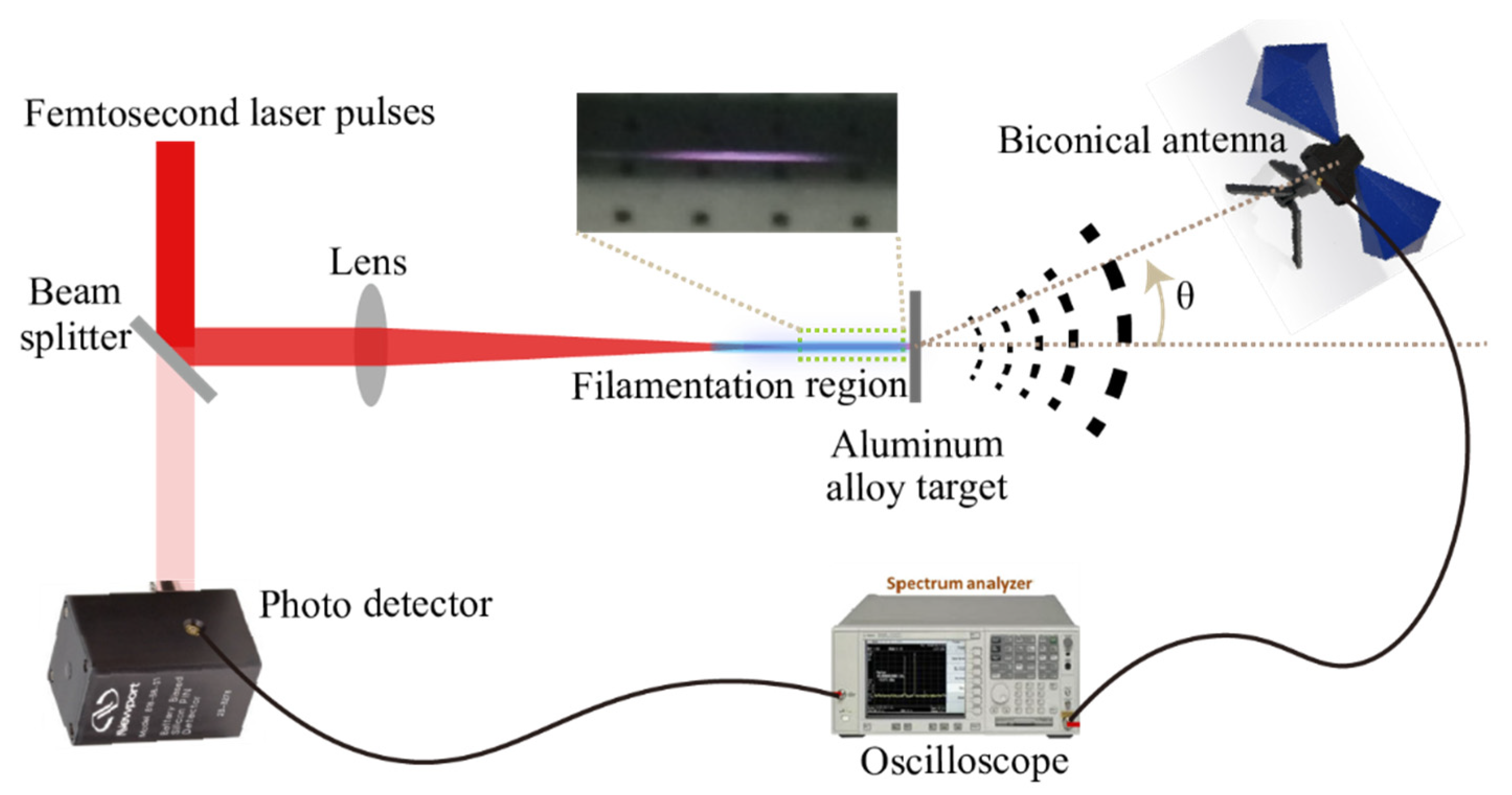
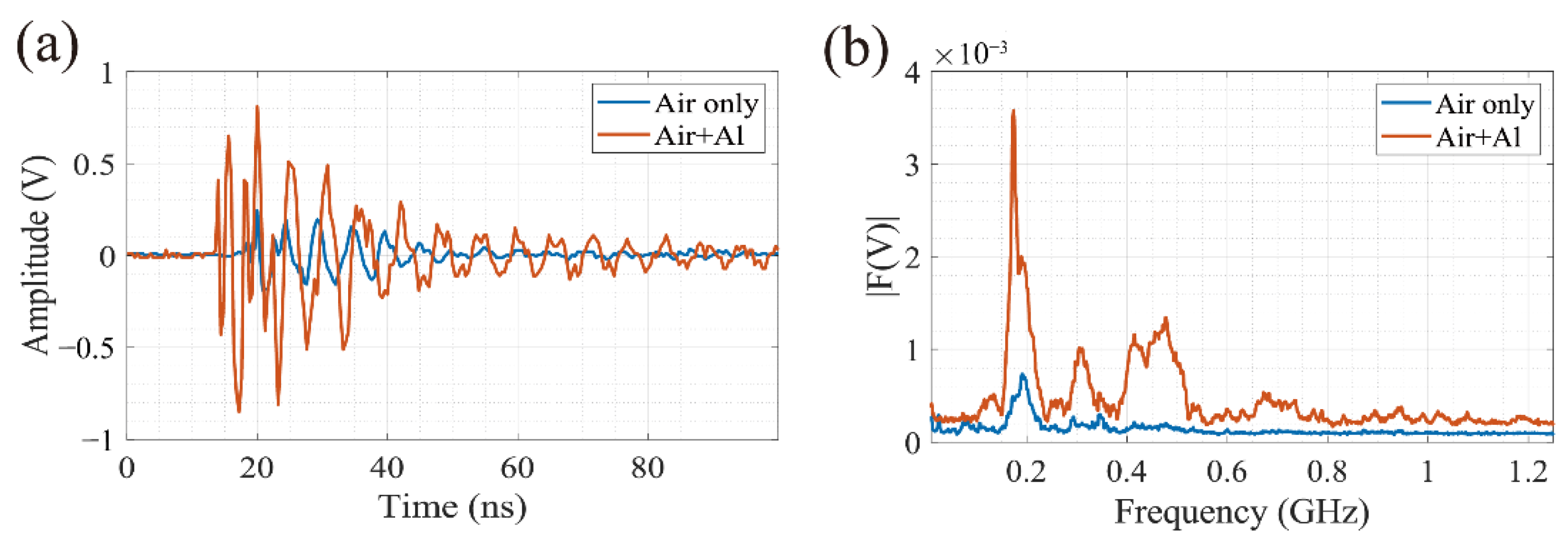
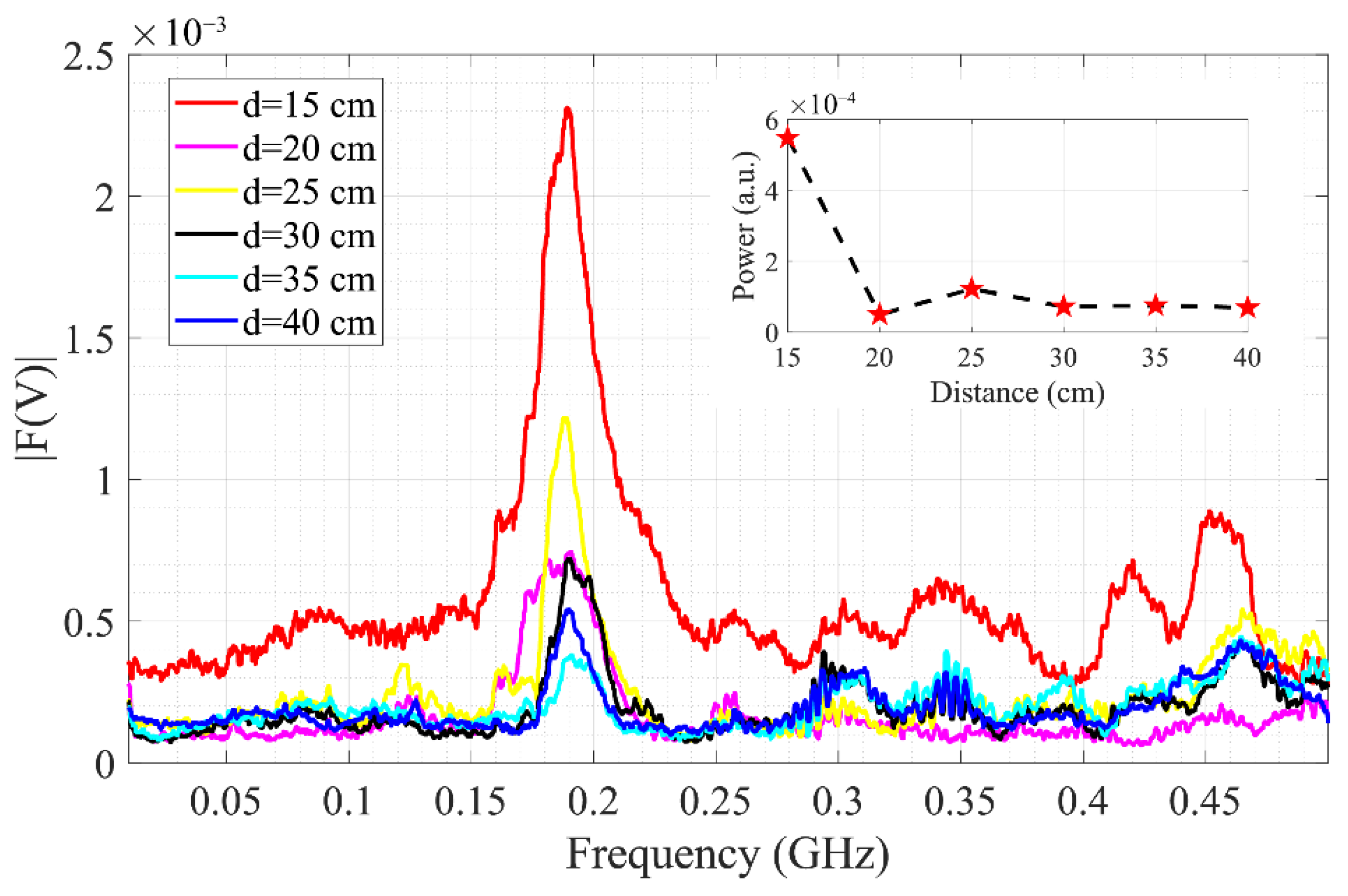
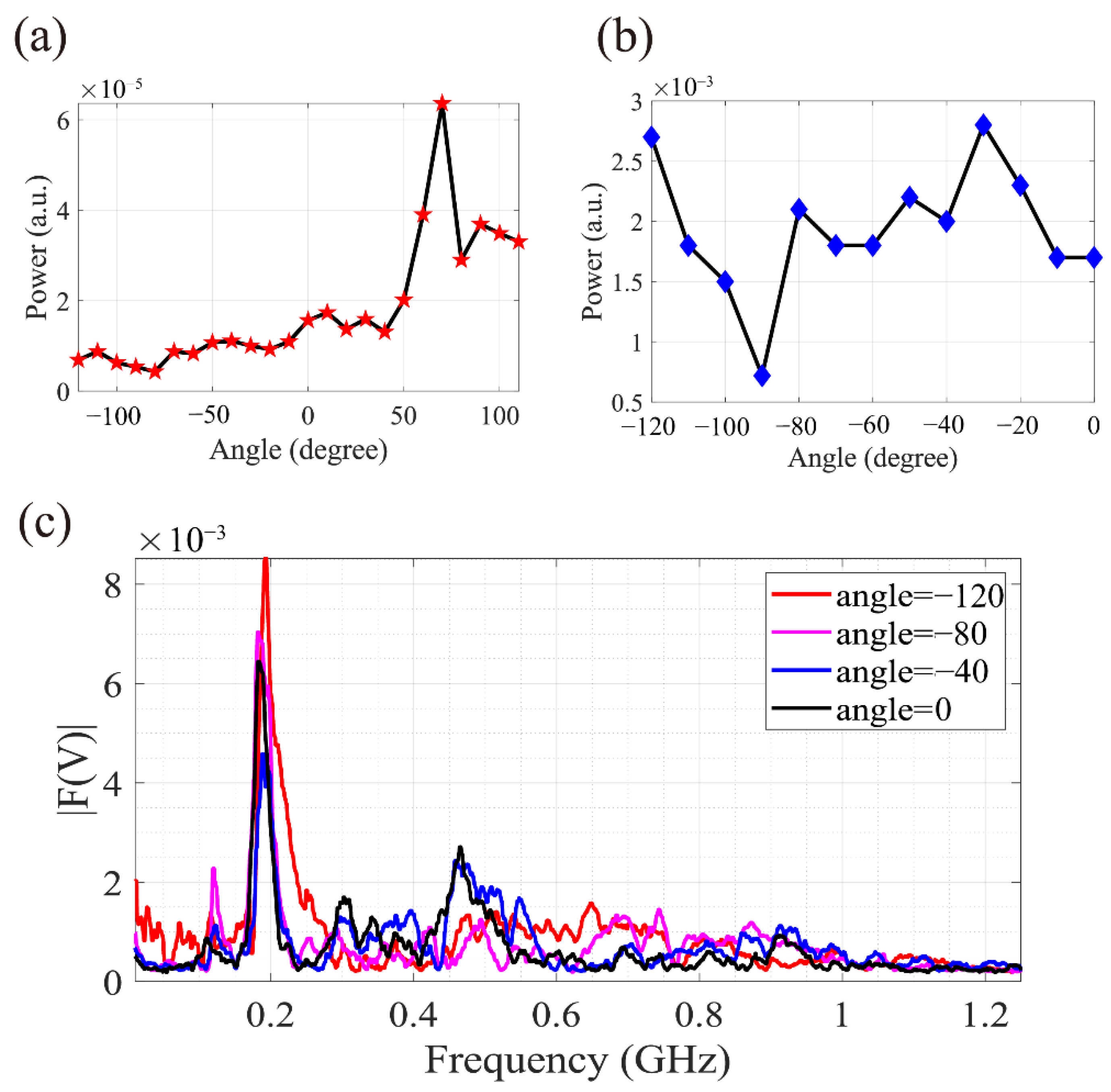
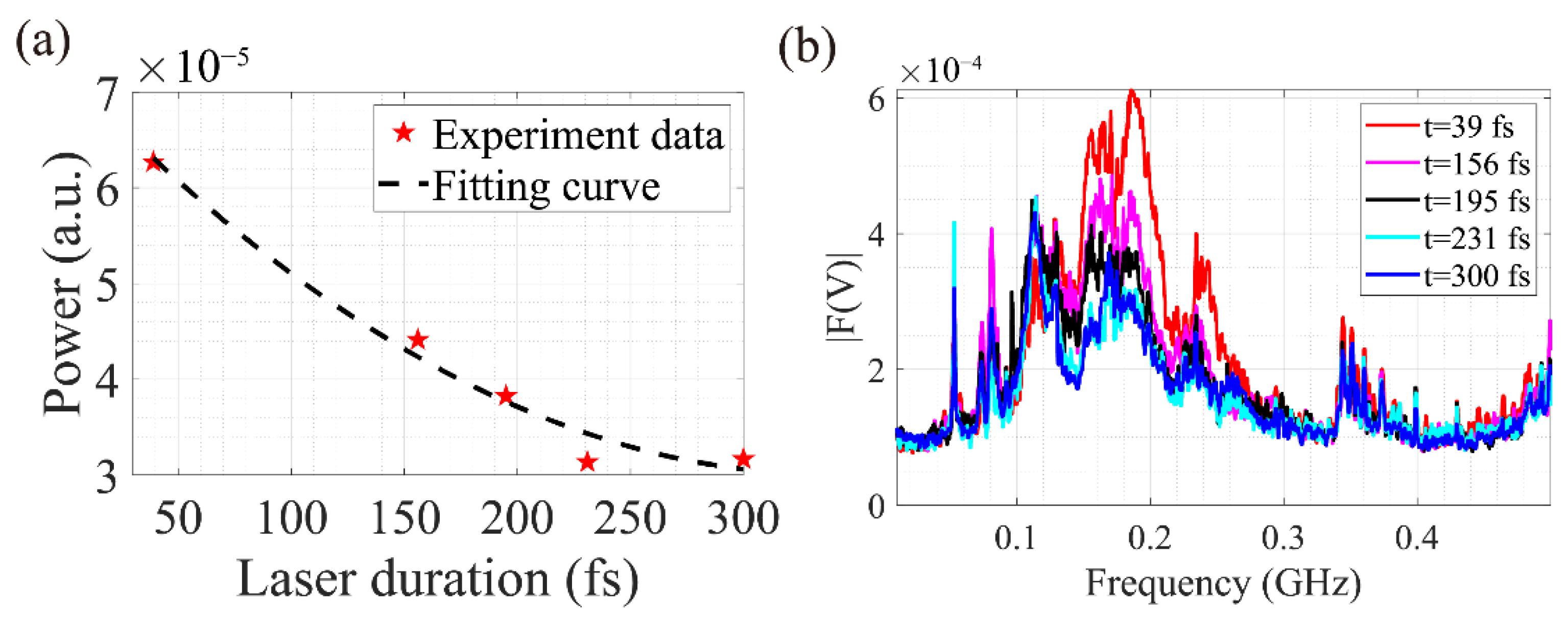
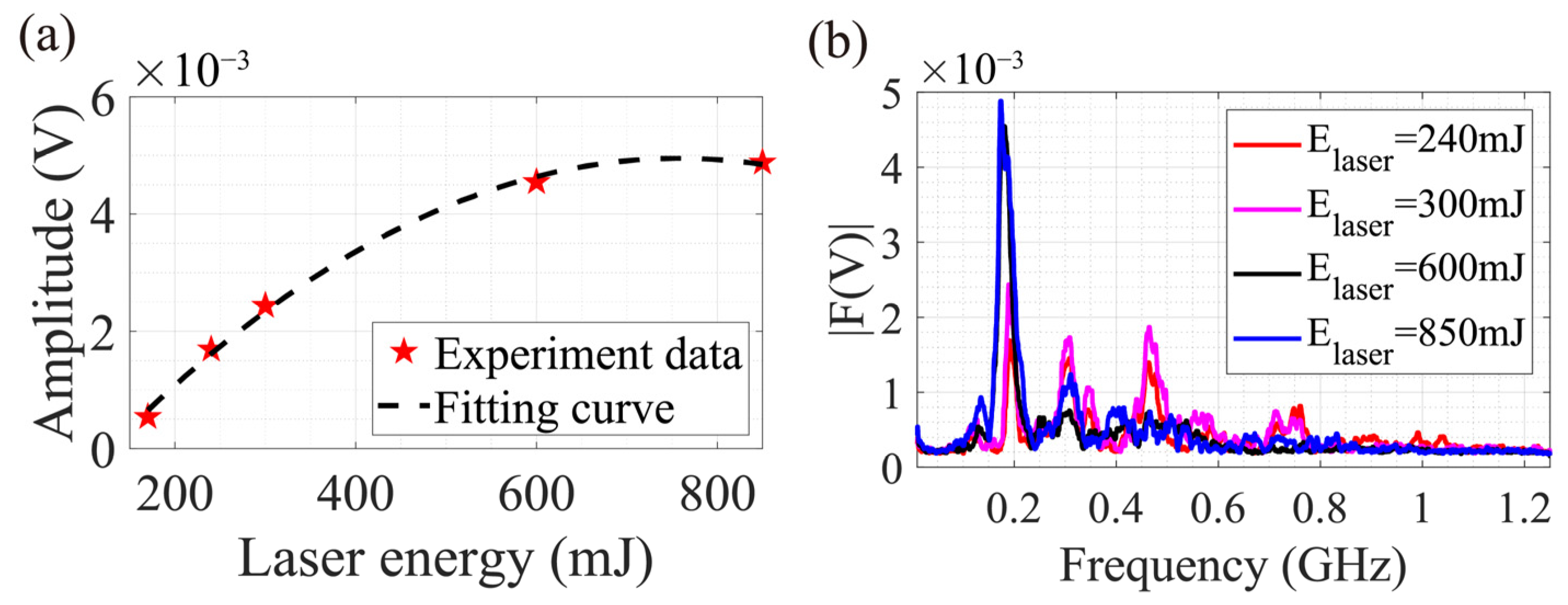
Publisher’s Note: MDPI stays neutral with regard to jurisdictional claims in published maps and institutional affiliations. |
© 2022 by the authors. Licensee MDPI, Basel, Switzerland. This article is an open access article distributed under the terms and conditions of the Creative Commons Attribution (CC BY) license (https://creativecommons.org/licenses/by/4.0/).
Share and Cite
Qi, R.; Zhou, C.; Zhang, D.; Song, L.; Yang, X.; Gui, J.; Leng, Y.; Tian, Y.; Li, R. Characterization of Electromagnetic Pulses Generated from Plasma Associated with Laser Filaments-Excited Aluminum Alloy Interaction. Appl. Sci. 2022, 12, 6059. https://doi.org/10.3390/app12126059
Qi R, Zhou C, Zhang D, Song L, Yang X, Gui J, Leng Y, Tian Y, Li R. Characterization of Electromagnetic Pulses Generated from Plasma Associated with Laser Filaments-Excited Aluminum Alloy Interaction. Applied Sciences. 2022; 12(12):6059. https://doi.org/10.3390/app12126059
Chicago/Turabian StyleQi, Rong, Chuliang Zhou, Dongdong Zhang, Liwei Song, Xiaojun Yang, Jiayan Gui, Yuxin Leng, Ye Tian, and Ruxin Li. 2022. "Characterization of Electromagnetic Pulses Generated from Plasma Associated with Laser Filaments-Excited Aluminum Alloy Interaction" Applied Sciences 12, no. 12: 6059. https://doi.org/10.3390/app12126059
APA StyleQi, R., Zhou, C., Zhang, D., Song, L., Yang, X., Gui, J., Leng, Y., Tian, Y., & Li, R. (2022). Characterization of Electromagnetic Pulses Generated from Plasma Associated with Laser Filaments-Excited Aluminum Alloy Interaction. Applied Sciences, 12(12), 6059. https://doi.org/10.3390/app12126059






